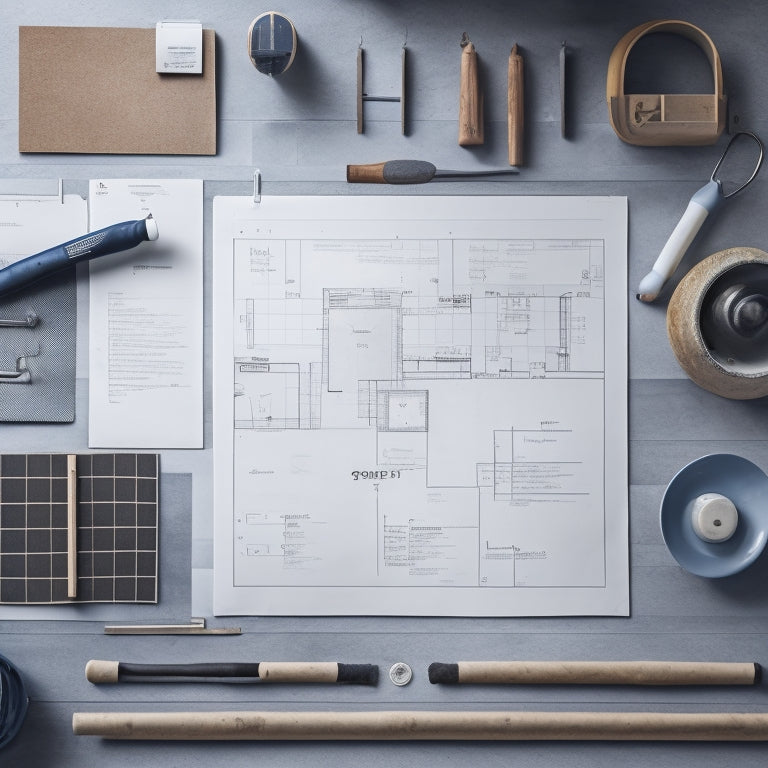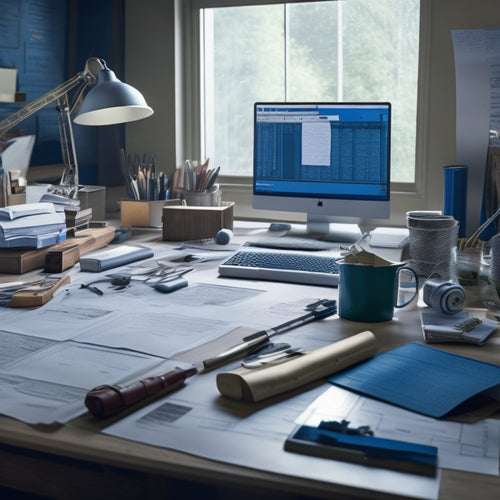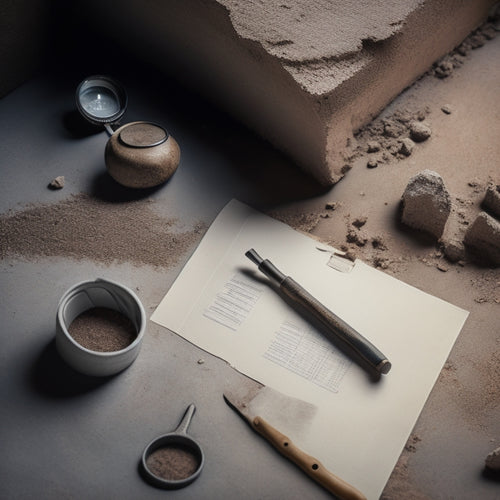
CSP Checklist for a Smooth Renovation Process
Share
As you start your renovation project, secure a smooth CSP process by following an essential checklist. First, prepare the concrete surface by thoroughly cleaning and evaluating its curing method to prevent delamination. Then, examine the existing condition, identifying cracks, unevenness, and defects, and document your findings. Next, choose the right equipment for your substrate condition, desired finish, and area size. After that, execute the profiling process, mechanically abrading the surface and removing contaminants. Finally, verify the finished surface, inspecting for imperfections and confirming it meets specified requirements. By following this checklist, you'll be well on your way to a successful renovation - and there's more to explore to guarantee its success.
Key Takeaways
• Thoroughly clean and prepare the concrete surface by removing old adhesives, oil, and contaminants to ensure a stable base.
• Assess the existing condition of the concrete substrate, identifying cracks, unevenness, and defects to address before application.
• Choose the right equipment for the job, considering the substrate condition, desired finish, and area size to prevent downtime and ensure performance.
• Execute the profiling process using selected equipment, following manufacturer's guidelines and wearing appropriate PPE to remove existing coatings and contaminants.
• Verify the finished surface, conducting a thorough inspection for imperfections and ensuring compliance with specified requirements for smoothness and flatness.
Prepare the Concrete Surface
Before applying a cementitious self-leveling product, make sure the concrete surface is thoroughly cleaned and free of old adhesives, oil, and other contaminants that may interfere with the bonding process.
You'll need to employ proper surface preparation techniques to guarantee a strong bond between the old concrete and the new self-leveling compound. This includes removing any dirt, dust, or laitance from the surface using a wire brush or floor scraper.
Additionally, you should assess the concrete curing methods used during the initial construction phase. If the concrete wasn't properly cured, it may have a weak surface that's prone to delamination.
In such cases, you may need to apply a surface retarder to expose the aggregate, followed by a thorough cleaning and neutralization of the surface.
By taking these steps, you'll create a clean, stable surface that's ready for the self-leveling product, guaranteeing a successful renovation project.
Assess the Existing Condition
You must evaluate the existing condition of the concrete substrate to identify any cracks, unevenness, or other defects that could impact the performance of the self-leveling compound. This evaluation is essential to guarantee a successful renovation process.
Take note of any current issues that could compromise the structural integrity of the substrate, such as signs of settlement, delamination, or previous repairs.
Conduct a thorough visual inspection, looking for any signs of damage, wear, or deterioration. Check for any cracks, fissures, or gaps in the concrete, as well as any unevenness or deviations in the surface. You should also check for any signs of water damage, staining, or efflorescence.
Document your findings, taking photos and notes to reference later. This will help you identify areas that require special attention or repair before applying the self-leveling compound.
Choose the Right Equipment
With the existing condition of the concrete substrate thoroughly assessed, you're now ready to select the right equipment for the renovation process. This vital step guarantees that you have the necessary tools to achieve the desired outcome while maintaining a safe working environment.
When it comes to equipment selection, it's important to take into account factors such as the substrate's condition, the desired finish, and the size of the area to be renovated. Additionally, you should also think about equipment maintenance to prevent downtime and guarantee peak performance.
Here's a checklist to help you choose the right equipment:
| Equipment | Considerations |
| Grinder | Substrate condition, desired finish, and area size |
| Scarifier | Aggressive profiling, heavy coating removal, and large areas |
| Shot Blaster | Delicate profiling, small areas, and dustless operation |
| Vacuum | Dust containment, air quality, and equipment protection |
Execute the Profiling Process
Now that you've selected the right equipment, it's time to execute the profiling process, which involves using your chosen equipment to mechanically abrade the concrete surface.
This process is vital for effective surface preparation, as it helps remove existing coatings, oil, grease, and other contaminants that can compromise the bond between the old and new surfaces.
When executing the profiling process, make sure to follow the manufacturer's guidelines and recommended profiling techniques for your specific equipment.
It's essential to wear appropriate personal protective equipment (PPE) during the profiling process, including safety glasses, gloves, and a dust mask.
Verify the work area is well-ventilated, and take regular breaks to avoid fatigue.
Keep the equipment in good working condition, and regularly inspect it for wear and tear.
By following these guidelines, you'll be able to achieve a properly profiled surface that's ready for the next stage of the renovation process.
Verify the Finished Surface
After completing the profiling process, the resulting surface must be thoroughly inspected to confirm it meets the required specifications for the renovation project.
You should carefully examine the surface for any imperfections, such as cracks, unevenness, or rough spots. These surface imperfections can affect the overall quality of the finished project, so it's crucial to identify and address them early on.
When verifying the finished surface, you should also consider the finishing techniques used to achieve the desired texture and appearance.
Check if the surface meets the specified requirements for smoothness, flatness, or other finish-related criteria.
Take note of any areas that require additional work, such as re-profiling or re-finishing, to confirm the surface meets the project's standards.
Frequently Asked Questions
What Is the Ideal Temperature for Concrete Surface Preparation?
When preparing a concrete surface, you'll want to verify the ideal temperature for best results.
Aim for a range between 50°F and 90°F (10°C and 32°C) to facilitate proper concrete curing. This temperature range allows for efficient surface leveling and prevents excessive shrinkage or cracking.
Avoid extreme temperatures, as they can compromise the structural integrity of the concrete, putting your safety and the project's success at risk.
How Do I Handle Unexpected Discoveries During the Renovation?
When renovation skeletons come out of the closet, don't let them spook you!
Unexpected discoveries can be challenging, but you're prepared. Stay calm, assess the situation, and communicate promptly with your contractor.
Together, you'll navigate budget adjustments and find a solution. Remember, safety first: halt work if necessary, and don't compromise on quality.
With open contractor communication, you'll tackle surprises like a pro and get back on track in no time.
Can I Reuse Old Materials to Reduce Waste and Costs?
When renovating, you'll likely encounter opportunities to reuse old materials.
Consider upcycling techniques to give new life to existing components, reducing waste and costs.
Before doing so, verify the materials are safe to reuse, inspecting for damage or deterioration.
Proper material sourcing is key; salvaged items must meet current building codes and regulations.
What Safety Measures Should I Take for Workers on Site?
You're about to commence a renovation project, and safety should be top of mind.
Did you know that, according to OSHA, construction accidents account for over 20% of all workplace fatalities?
To guarantee a safe site, you must prioritize worker training on potential site hazards.
Identify and mitigate risks by conducting regular site audits, providing personal protective equipment, and establishing clear emergency procedures.
How Long Will the Renovation Process Typically Take to Complete?
You're wondering how long the renovation process will take to complete. A well-planned renovation timeline is essential for a stress-free project.
Typically, it can take anywhere from a few weeks to several months, depending on the scope of the project. Effective project management is key to staying on track.
You'll need to take into account factors like material delivery, labor availability, and inspections. By creating a realistic timeline and sticking to it, you'll guarantee a smooth renovation process that meets your needs and keeps workers safe.
Conclusion
As you stand victorious on the battlefield of your renovation project, the finished surface shining like the armor of Achilles, you can't help but feel a sense of pride and accomplishment.
The CSP checklist has been your trusted shield, guiding you through the process and protecting you from potential pitfalls.
With each step meticulously executed, you've emerged victorious, ready to take on the next challenge that comes your way.
The smooth renovation process is your trophy, and it's a proof of your unwavering dedication.
Related Posts
-

Create a Home Renovation Project Timeline in Excel
You can create a detailed home renovation project timeline in Excel by setting up a tailored template with separate w...
-

Crack Repair Inspection Checklist for Home Renovation
When creating a crack repair inspection checklist for your home renovation project, you'll want to identify crack typ...
-

5 Vital Safety Tips for DIY Renovation Success
When tackling a DIY renovation, you'll need to prioritize safety above all else. Start by protecting yourself from fl...


